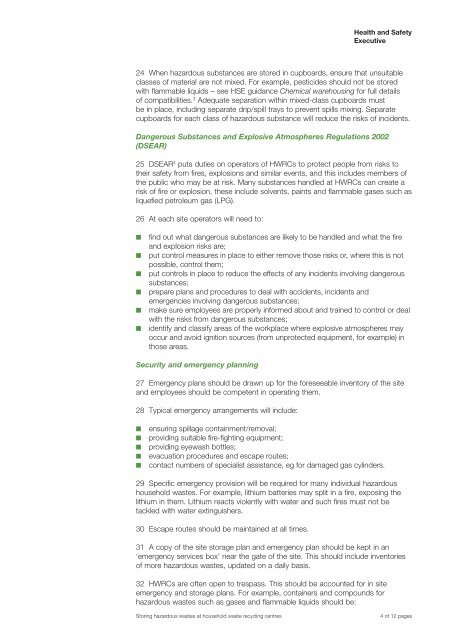Storing hazardous wastes at household waste recycling centres - HSE
Storing hazardous wastes at household waste recycling centres - HSE
Storing hazardous wastes at household waste recycling centres - HSE
Create successful ePaper yourself
Turn your PDF publications into a flip-book with our unique Google optimized e-Paper software.
Health and Safety<br />
Executive<br />
24 When <strong>hazardous</strong> substances are stored in cupboards, ensure th<strong>at</strong> unsuitable<br />
classes of m<strong>at</strong>erial are not mixed. For example, pesticides should not be stored<br />
with flammable liquids – see <strong>HSE</strong> guidance Chemical warehousing for full details<br />
of comp<strong>at</strong>ibilities. 3 Adequ<strong>at</strong>e separ<strong>at</strong>ion within mixed-class cupboards must<br />
be in place, including separ<strong>at</strong>e drip/spill trays to prevent spills mixing. Separ<strong>at</strong>e<br />
cupboards for each class of <strong>hazardous</strong> substance will reduce the risks of incidents.<br />
Dangerous Substances and Explosive Atmospheres Regul<strong>at</strong>ions 2002<br />
(DSEAR)<br />
25 DSEAR 4 puts duties on oper<strong>at</strong>ors of HWRCs to protect people from risks to<br />
their safety from fires, explosions and similar events, and this includes members of<br />
the public who may be <strong>at</strong> risk. Many substances handled <strong>at</strong> HWRCs can cre<strong>at</strong>e a<br />
risk of fire or explosion, these include solvents, paints and flammable gases such as<br />
liquefied petroleum gas (LPG).<br />
26 At each site oper<strong>at</strong>ors will need to:<br />
■■<br />
■■<br />
■■<br />
■■<br />
■■<br />
■■<br />
find out wh<strong>at</strong> dangerous substances are likely to be handled and wh<strong>at</strong> the fire<br />
and explosion risks are;<br />
put control measures in place to either remove those risks or, where this is not<br />
possible, control them;<br />
put controls in place to reduce the effects of any incidents involving dangerous<br />
substances;<br />
prepare plans and procedures to deal with accidents, incidents and<br />
emergencies involving dangerous substances;<br />
make sure employees are properly informed about and trained to control or deal<br />
with the risks from dangerous substances;<br />
identify and classify areas of the workplace where explosive <strong>at</strong>mospheres may<br />
occur and avoid ignition sources (from unprotected equipment, for example) in<br />
those areas.<br />
Security and emergency planning<br />
27 Emergency plans should be drawn up for the foreseeable inventory of the site<br />
and employees should be competent in oper<strong>at</strong>ing them.<br />
28 Typical emergency arrangements will include:<br />
■■<br />
■■<br />
■■<br />
■■<br />
■■<br />
ensuring spillage containment/removal;<br />
providing suitable fire-fighting equipment;<br />
providing eyewash bottles;<br />
evacu<strong>at</strong>ion procedures and escape routes;<br />
contact numbers of specialist assistance, eg for damaged gas cylinders.<br />
29 Specific emergency provision will be required for many individual <strong>hazardous</strong><br />
<strong>household</strong> <strong><strong>waste</strong>s</strong>. For example, lithium b<strong>at</strong>teries may split in a fire, exposing the<br />
lithium in them. Lithium reacts violently with w<strong>at</strong>er and such fires must not be<br />
tackled with w<strong>at</strong>er extinguishers.<br />
30 Escape routes should be maintained <strong>at</strong> all times.<br />
31 A copy of the site storage plan and emergency plan should be kept in an<br />
‘emergency services box’ near the g<strong>at</strong>e of the site. This should include inventories<br />
of more <strong>hazardous</strong> <strong><strong>waste</strong>s</strong>, upd<strong>at</strong>ed on a daily basis.<br />
32 HWRCs are often open to trespass. This should be accounted for in site<br />
emergency and storage plans. For example, containers and compounds for<br />
<strong>hazardous</strong> <strong><strong>waste</strong>s</strong> such as gases and flammable liquids should be:<br />
<strong>Storing</strong> <strong>hazardous</strong> <strong><strong>waste</strong>s</strong> <strong>at</strong> <strong>household</strong> <strong>waste</strong> <strong>recycling</strong> <strong>centres</strong><br />
4 of 12 pages

















